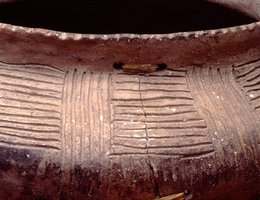

The Redbird culture in northeastern Nebraska left an archaeological record that is similar to the Lower Loup culture, but Redbird sites were smaller villages and we find slightly different pottery styles at these sites.
Ponca and Omaha oral history suggests that the Redbird people immigrated into northeastern Nebraska about 1700 CE. Some archaeologists agree and maintain that the evidence shows that the Redbird culture descended into the Ponca. However, other archaeologists feel they are more likely ancestral to the Pawnee. Consequently, it is difficult to say with any degree of certainty what the ethnic identification of the Redbird phase is.
Oneota cultural sites have been found in several areas of eastern Nebraska.
The Oneota culture and economy was close to that of eastern Woodlands groups, but they adopted or created many of the same patterns they found in their plains neighbors. The most obvious adaptations were the earth lodges they learned to build and the way they learned to hunt bison. They were also closely related to the Redbird and Lower Loup cultures. Unfortunately, very little work has been done on this culture in Nebraska and little can be said about settlement patterns. The Oneota culture probably contributed to the development of the Ponca, Omaha, and Oto tribes in Nebraska.